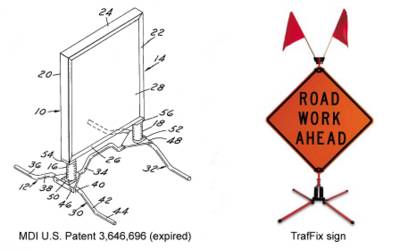Recommended Reading: Following the Direction of TrafFix: Trade Dress Law and Functionality Revisited
In an article in the latest issue of IDEA (published by Franklin Pierce Law School) entitled "Following the Direction of TrafFix: Trade Dress Law and Functionality Revisited," Professor Amy Cohen of Western New England College School of Law reviews the history of product configuration trade dress law, including its expansion in the 1980s through the Supreme Court's attempt in TrafFix Devices Inc. v. Marketing Displays Inc., 532 U.S. 23, 58 USPQ2d 1001 (2001), to narrow trade dress protection by providing a broader definition of functionality.

Professor Cohen finds that "[d]espite its seeming clarity, many scholars have struggled to make sense of the TrafFix decision, and many courts have struggled to apply it."
The federal courts have split in their interpretations and applications of the TrafFix holding. In particular, the Trademark Trial and Appeal Board (“TTAB”) and its reviewing court, the Federal Circuit Court of Appeals, have essentially continued to apply a definition of functionality that was followed prior to the TrafFix decision, while paying the case lip service.
Professor Cohen argues that, in the last five years, the case law "has continued to be confused and inconsistent." This lack of clarity in the law "is costly to producers. More importantly, it is costly to consumers who will ultimately bear the burden of this litigation in the prices they pay for products." She proposes a rather radical solution to the problem:
Society’s interest in obtaining the best goods at the lowest cost is being hampered by the doctrine of functionality and the potential protection afforded to the design of useful products. Consumers and competitors would be much better off in a world where there was no trade dress protection for product designs. Patent law and copyright law provide adequate incentives to promote the creation of useful and aesthetically pleasing products, and the concern with consumer confusion can be best dealt with by labeling and disclosure requirements.
It is time to return to the approach followed for many years before the twists and turns in trade dress law that began in the 1970s. Congress should amend the Lanham Act to prevent registration and protection of the configuration of useful products.
TTABlog note: for more reading on this issue, see Karl Horlander, "The U.S. Constitutional Limits of Product Configuration Trade Dress Rights," 97 Trademark Reporter 752 (May-June 2007); and Clifford W. Browning, "TrafFix Revisited: Exposing the Design Flaw in the Functionality Doctrine," 94 Trademark Reporter 1059 (September-October 2004) [TTABlogged here].

Text Copyright John L. Welch 2010.




1 Comments:
John, I have not read the paper as yet, but I cannot agree with the idea that trademark law should be limited because such limitation "might" result in lower costs to consumers or because the courts have mis-interpreted the law. The trademark statute clearly provides that basically anything that identifies and distinguishes the source of a product or service is entitled to protection. The more importatnt public policy issue here is the avoidance of the likelihood of confusion. The only way to go back to the days of no trade dress protection would be to change the statute, and thats not going to happen.
Question for you John. Can a patented design, current or expired, also be subject to trademark potection or does patent law prohibit the continuation of the monopolopy? I am not really sure about that. Maybe the obvious answer is no, but its something that I have been thinking about lately and you know me, I don't like to assume anything. Thanks.
Post a Comment
<< Home